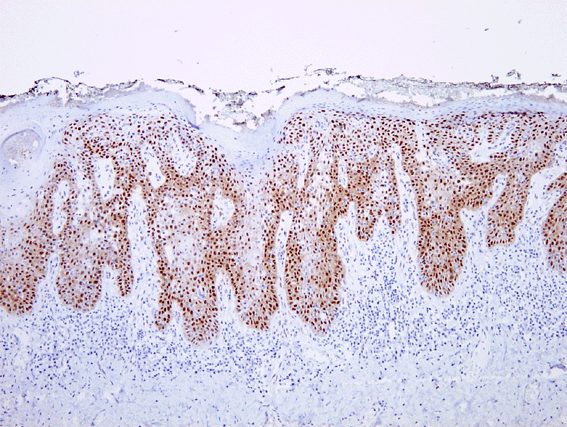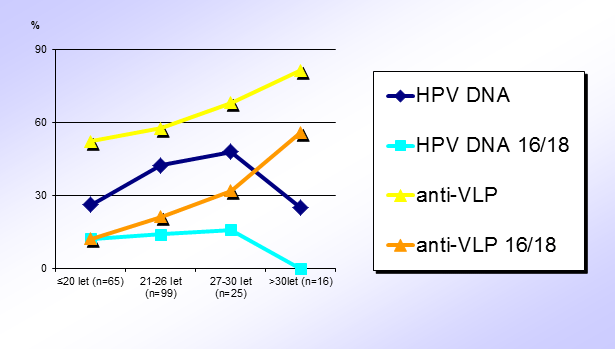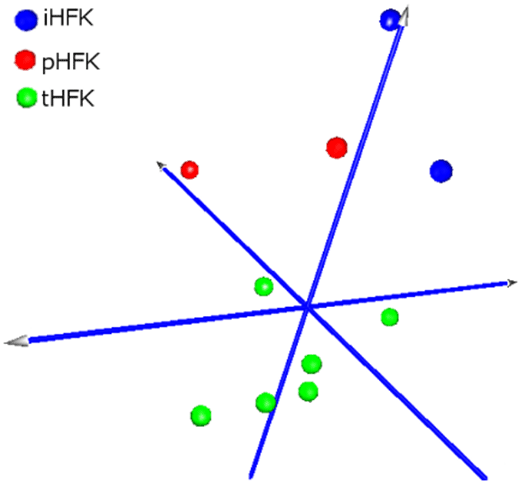Laboratory of Molecular and Tumour Virology
Head:
doc. RNDr. Ruth Tachezy, Ph.D.
Department of Genetics and Microbiology
Head
BIOCEV Vestec, 2NP, room A2.016
Viničná 5, 2NP, room 117A
Where to Find Us:
BIOCEV, Průmyslová 595, Vestec, 252 42
the first floor, Wing 3 (rooms 004, 007, 015, 016)
Team MembersMethodology and Technical SupportScientific CollaborationsPublications |
TeachingProposed Topics of Theses for New StudentsStudent Theses in ProgressPast Student Theses |
Research Interests
 The Laboratory of Molecular and Tumor Virology was established in 2015 by a group of researchers who transferred from the Institute of Hematology and Blood Transfusion (IHBT) in Prague. They joined the research team "Identification of Targets for Diagnosis and Therapy of Tumor Diseases Associated with Human Viruses" as part of the Cellular Biology and Virology programme at the then newly established BIOCEV research center in Vestec. The laboratory continues to work closely with the National Reference Laboratory for Papillomaviruses and Polyomaviruses, which was originally part of the IHBT and is now based at the Public Health Institute Ostrava. Our projects also involve close collaboration with the Laboratory of Immunotherapy and Laboratory fo Virology of the Department of Genetics and Microbiology, Faculty of Science, Charles University. In 2024, we became part of the National Institute of Virology and Bacteriology, which is a platform uniting top scientific institutions from the whole Czech Republic; we participate in its programmes "Pathogen-Host Interactions" and "Immunity Against Viruses and Bacteria".
The Laboratory of Molecular and Tumor Virology was established in 2015 by a group of researchers who transferred from the Institute of Hematology and Blood Transfusion (IHBT) in Prague. They joined the research team "Identification of Targets for Diagnosis and Therapy of Tumor Diseases Associated with Human Viruses" as part of the Cellular Biology and Virology programme at the then newly established BIOCEV research center in Vestec. The laboratory continues to work closely with the National Reference Laboratory for Papillomaviruses and Polyomaviruses, which was originally part of the IHBT and is now based at the Public Health Institute Ostrava. Our projects also involve close collaboration with the Laboratory of Immunotherapy and Laboratory fo Virology of the Department of Genetics and Microbiology, Faculty of Science, Charles University. In 2024, we became part of the National Institute of Virology and Bacteriology, which is a platform uniting top scientific institutions from the whole Czech Republic; we participate in its programmes "Pathogen-Host Interactions" and "Immunity Against Viruses and Bacteria".
Our Laboratory has long focused on the molecular epidemiology of papillomaviruses, polyomaviruses, and the study of newly discovered small DNA viruses. To determine viral etiology in diseases, we use both direct methods for detecting viral agents and indirect methods such as serological and immunohistochemical techniques. We are also involved in the surveillance of certain viral diseases, particularly in relation to the implementation or modification of preventive screening and vaccination programs. Some viral infection-associated diseases are used as model systems for identifying diagnostic and therapeutic targets.
The Laboratory's work also includes research on animal papillomaviruses. In the past, we participated in the identification of several new animal papillomaviruses, and we continue to apply this expertise in diagnosing infections in animals that clinically manifest as papillomavirus-associated diseases - papillomas, fibromas, fibropapillomas, and sarcomas
 The Laboratory has also focused on the surveillance of human papillomaviruses (HPV) in relation to the implementation of an organized cervical cancer screening program, which is almost 100% associated with infection by high-risk (HR) HPV types, and in connection with the introduction of widespread HPV vaccination. We analyzed type-specific prevalence of HPV infections in pre-malignant and malignant diseases associated with HPV in the Czech population, assessed type-specific prevalence in the screening population of Czech women, and also examined the seroprevalence of HPV-specific antibodies in both the healthy population and in patients. In our study of HPV infection prevalence in the vaccinated female population of the Czech Republic, we found a high prevalence of a wide range of HPV types among young women. Among these women, 11% were incidentally and/or persistently infected with HR vaccine-type HPV, suggesting a reduced vaccine efficacy. Only half of these women had HPV-specific antibodies, indicating that HPV vaccination will be very beneficial even for sexually active women.
The Laboratory has also focused on the surveillance of human papillomaviruses (HPV) in relation to the implementation of an organized cervical cancer screening program, which is almost 100% associated with infection by high-risk (HR) HPV types, and in connection with the introduction of widespread HPV vaccination. We analyzed type-specific prevalence of HPV infections in pre-malignant and malignant diseases associated with HPV in the Czech population, assessed type-specific prevalence in the screening population of Czech women, and also examined the seroprevalence of HPV-specific antibodies in both the healthy population and in patients. In our study of HPV infection prevalence in the vaccinated female population of the Czech Republic, we found a high prevalence of a wide range of HPV types among young women. Among these women, 11% were incidentally and/or persistently infected with HR vaccine-type HPV, suggesting a reduced vaccine efficacy. Only half of these women had HPV-specific antibodies, indicating that HPV vaccination will be very beneficial even for sexually active women.
In collaboration with Medical Healthcom Ltd. (Prague Voice Center) we conducted a study on the effect of HPV vaccination in patients with benign laryngeal disease - recurrent laryngeal papillomatosis (RLP), which is caused by low-risk (LR) HPV types, particularly type 6. Although it is a benign disease, it is characterized by significant morbidity and the potential for malignant conversion. Current treatment options are limited. HPV vaccination with the quadrivalent vaccine, which contains antigens against HPV6 and 11, could improve quality of life for patients. In our previous studies, we showed that RLP patients often lack antibodies against the HPV types causing the condition, with these antibodies only appearing after multiple surgical interventions to remove papillomas. Vaccination is expected to stimulate a robust antibody response and induce the presence of neutralizing antibodies on the surface of the upper respiratory tract mucosa, which would slow/inhibit the growth of HPV-associated lesions. Our Phase IIIb clinical trial evaluated the effect of quadrivalent HPV vaccination on the recurrence frequency in RLP patients.
Our team has also been intensely involved in studying the relationship between HPV and vulvar carcinoma, anal carcinoma, bladder cancer, and prostate cancer. We are currently collaborating on a project to optimize the diagnostic and therapeutic management of condylomas, precancerous lesions, and vulvar carcinomas with the Department of Obstetrics and Gynaecology and the Department of Pathology and Molecular Medicine at the Second Faculty of Medicine, Charles University, and Motol University Hospital. In addition to viral infection markers, we assess the relationship of p16, p53, and SOX2 protein expression to lesion type and HPV presence.
Since 2001, we have been collaborating with the Department of Otorhinolaryngology and Head and Neck Surgery at the First Faculty of Medicine, Charles University, and Motol University Hospital, on a study of HPV infection etiology in patients with head and neck cancers. In this study, we demonstrated that oropharyngeal cancers are up to 69% associated with active HR HPV infection. In further studies, we also described risk factors for patients with HPV-associated and non-associated tumors. We showed that traditional prognostic markers, currently used in clinical practice, may not have the same predictive value for patients with HPV-associated tumors. Given that HPV-associated tumor patients respond better to treatment and have better survival rates, the issue of viral infection diagnosis in clinical practice and the possibility of modifying treatment for these patients has arisen. Our study evaluated the relationship between viral etiology of oropharyngeal tumors and the success of different treatment modalities. The results point to the possibility of modifying treatment procedures for patients with HPV-associated tumors and will form the basis for treatment recommendations for these patients in the Czech Republic. In terms of diagnosing HPV-associated tumors, we demonstrated the necessity of combining two methods - PCR detection of HPV DNA and detection of p16 protein expression - for unequivocal proof of the viral etiology of these tumors. Our studies will result in recommendations for the combination and sequence of methods in clinical practice.
 In our latest research projects, we are studying the expression profiles of miRNAs in head and neck cancers (HNC) in relation to disease etiology and prognosis, with the goal of identifying miRNAs that could serve as therapeutic and diagnostic markers for specific HNC subgroups. Unlike cervical carcinomas, which are almost always linked to HPV infection, HPV-positive and HPV-negative HNC represent a unique model for studying cancer caused by different molecular mechanisms - virus-related and virus-independent. We compared miRNA expression profiles of tonsillar tumors characterized by etiology and HPV genome status. We compared these expression profiles with those of cervical carcinomas and the expression profiles of a model system of human keratinocytes immortalized by HPV or the human telomerase gene. We identified so-called "HPV core" miRNAs specific to HPV-associated tumors and miRNAs specific to HPV-associated tonsillar tumors and tonsillar tumors with non-viral etiology. In further analyses, we will validate the presence of HPV core miRNAs in other HPV-associated tumors of various anatomical locations and conduct functional tests on selected miRNAs.
In our latest research projects, we are studying the expression profiles of miRNAs in head and neck cancers (HNC) in relation to disease etiology and prognosis, with the goal of identifying miRNAs that could serve as therapeutic and diagnostic markers for specific HNC subgroups. Unlike cervical carcinomas, which are almost always linked to HPV infection, HPV-positive and HPV-negative HNC represent a unique model for studying cancer caused by different molecular mechanisms - virus-related and virus-independent. We compared miRNA expression profiles of tonsillar tumors characterized by etiology and HPV genome status. We compared these expression profiles with those of cervical carcinomas and the expression profiles of a model system of human keratinocytes immortalized by HPV or the human telomerase gene. We identified so-called "HPV core" miRNAs specific to HPV-associated tumors and miRNAs specific to HPV-associated tonsillar tumors and tonsillar tumors with non-viral etiology. In further analyses, we will validate the presence of HPV core miRNAs in other HPV-associated tumors of various anatomical locations and conduct functional tests on selected miRNAs.
Another project we are working on aims to elucidate the mechanism of carcinogenesis in tumors associated with HPV infection, where the virus is present not in an integrated but in an extrachromosomal form. We are conducting methylation and sequencing analyses of the viral genome's regulatory region, particularly the binding sites for the early viral protein E2, which functions as a transcriptional regulatory factor for the transcription of viral oncoproteins E6 and E7.
Another focus of our research group is the immunoprofiling of immune cells from peripheral blood and immune cells infiltrating HNC. The characterization of the immune response is a critical prognostic tool for many cancers, potentially even more important than the current tumor classification system. The results of our studies could help identify new targets for therapeutic strategies, including cancer immunotherapy, and improve the understanding of the pathophysiology of virus-induced tumors. Our pilot results showed that a lower CD8+/CD4+CD25+ T cell ratio in peripheral blood positively influences overall survival, independent of HPV status. Patients with HPV-associated tumors have higher levels of CD8+ T cells. In tumor tissue, patients with virus-associated tumors had higher levels of IFN-γ CD8+ lymphocytes, IL-17+ CD8+ lymphocytes, myeloid dendritic cells, and pro-inflammatory cytokines. HPV-positive tumors had lower Cox-2 mRNA expression and higher PD1 mRNA expression. Currently, in collaboration with the Laboratory of Immunotherapy at the Faculty of Science, and the Department of Pediatric Haematology and Oncology at the Second Faculty of Medicine, Charles University, and Motol University Hospital, we are working on implementing methods for detecting, quantifying, and phenotyping immune cells in peripheral blood and tumors using the CyTOF mass spectrometer. For the detection, quantification, and phenotyping of cells in fixed tissue (so-called tissue cytometry or in situ cytometry), we have acquired a unique multimodal and multispectral instrument Mantra (PerkinElmer).
In addition to clinical materials/native tissue, we are now beginning to focus on studying the HPV life cycle, including infectivity, transmission, and the ability of the virus to interact with host cells and structures in vitro. Given that the HPV life cycle is closely tied to host cell differentiation, producing the virus in cell culture is challenging. Therefore, systems have been developed to produce recombinant papillomavirus particles, such as virus-like particles (VLPs), generated by infecting insect cells with recombinant baculoviruses carrying the capsid protein genes of the respective viruses, or pseudovirions (PsVs) produced in HEK 293 cells containing viral DNA. Another model system for studying HPV is human keratinocytes immortalized by viral DNA, which mimics the early phase of viral infection.
The Laboratory team also investigated the newly discovered TT virus in relation to post-transfusion hepatitis of unknown origin. In an epidemiological study, we found a significant prevalence of this virus in the population. It has been demonstrated that this virus is transmitted through blood and also sexually. However, its role in post-transfusion hepatitis has not been confirmed. TT virus infection is significantly more common in patients after allogeneic hematopoietic cell transplantation, with a higher viral load than in the healthy population. The kinetics of the viral load corresponds to the reconstitution of the patients' immune systems.
 Additionally, the Laboratory is intensively studying human polyomaviruses, particularly the epidemiology of human polyomaviruses HPyV6, HPyV7, TSPyV, HPyV9, MWPyV, KIPyV, and MCPyV, which were discovered through molecular-biological methods between 2007 and 2012. Besides the ELISA test for detecting antibodies against all known polyomaviruses, we have developed tests for quantifying viral DNA. These tests are applicable in clinical practice. Currently, we are also focusing on MCPyV, which is the etiological agent of Merkel cell carcinoma, a skin tumor. MCPyV is the only known human polyomavirus that contributes to tumor development. A monoclonally integrated and replication-defective form of the viral genome is found in 80-95% of Merkel cell carcinomas, a neuroendocrine tumor with low incidence. TSPyV causes the rare skin condition trichodysplasia spinulosa, while the role of other polyomaviruses in human pathology remains unknown. In collaboration with Vojtěch Šroller, Ph.D., from the Laboratory of Virology, we would like to continue characterizing MCPyV in Merkel cell carcinoma and studying its life cycle. The specific properties of the viral life cycle are likely crucial for the pathogenesis of Merkel cell carcinoma, particularly concerning the little-known events leading to tumor formation (e.g., site of productive viral replication, infection of permissive vs. non-permissive cells, sequence of events during integration, and changes in the host genome).
Additionally, the Laboratory is intensively studying human polyomaviruses, particularly the epidemiology of human polyomaviruses HPyV6, HPyV7, TSPyV, HPyV9, MWPyV, KIPyV, and MCPyV, which were discovered through molecular-biological methods between 2007 and 2012. Besides the ELISA test for detecting antibodies against all known polyomaviruses, we have developed tests for quantifying viral DNA. These tests are applicable in clinical practice. Currently, we are also focusing on MCPyV, which is the etiological agent of Merkel cell carcinoma, a skin tumor. MCPyV is the only known human polyomavirus that contributes to tumor development. A monoclonally integrated and replication-defective form of the viral genome is found in 80-95% of Merkel cell carcinomas, a neuroendocrine tumor with low incidence. TSPyV causes the rare skin condition trichodysplasia spinulosa, while the role of other polyomaviruses in human pathology remains unknown. In collaboration with Vojtěch Šroller, Ph.D., from the Laboratory of Virology, we would like to continue characterizing MCPyV in Merkel cell carcinoma and studying its life cycle. The specific properties of the viral life cycle are likely crucial for the pathogenesis of Merkel cell carcinoma, particularly concerning the little-known events leading to tumor formation (e.g., site of productive viral replication, infection of permissive vs. non-permissive cells, sequence of events during integration, and changes in the host genome).
Within the polyomavirus group, we also plan to further investigate the BK virus. The planned study will focus on determining the type-specific prevalence of BK virus in a high-risk population of immunosuppressed and oncology patients, aiming to assess the risk of reactivation versus new type infection leading to hemorrhagic cystitis and nephropathy in these patients.





















